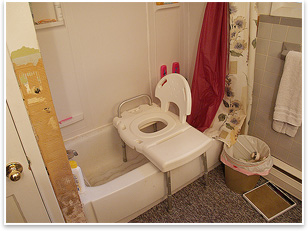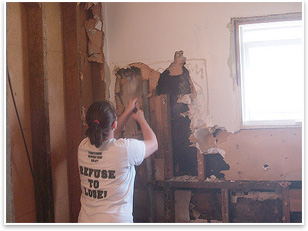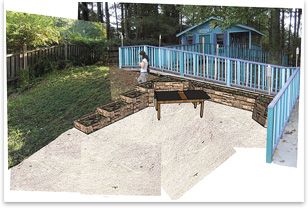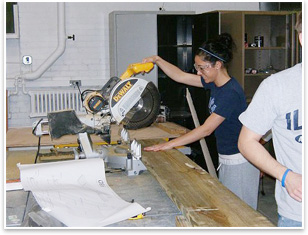
| AIAS
freedom by design Students Making a Difference How do you: Create a hands-on learning experience that also builds community? Summary: The American Institute of Architecture Students, through its school chapters, took the idea of an AIA member and ran with it, creating a mission, Freedom by Design, by which creativity applied to real-life limitations expands the capabilities of people with disabilities. “Across the U.S., there are large numbers of people who are trapped in their own homes,” the students explain. “They cannot, with any ease, get into their own showers, ascend steps, or reach into a cabinet to get a bowl. There are people who cannot escape their homes in case of emergency. Small changes to their homes can significantly change their lives.”
FBD began in 2000 as an idea put forth by Brad Buchanan, FAIA, an architect in Denver. Within four years, the FBD organization had completed over $300,000 in built construction with only $4,000 in donated seed money. Citizens in Denver were excited about FBD, and architects and students around the country were beginning to hear about it and wanted to contribute. As the program expanded rapidly, Buchanan realized that the current structure was not sustainable and began looking for an organization to take this program to the national level.
In 2004, the pilot program involved six AIAS chapters representing a diverse group of communities. Preparation included an orientation session in Denver, and the students set to work. Despite some setbacks and growing pains, the final results were conclusive. And, with changes as seemingly small as installing handrails in bathrooms to as large as installing accessible ramps outside of the home, the students helped people across the country create homes that are welcoming, useable living spaces.
A full-blown national initiative
|
||
Copyright 2008 The American Institute of Architects. All rights reserved. Home Page |
||
news headlines
practice
business
design
As preparation for the 2008-2009 FBD projects gets under way, the AIAS continues to solicit sponsorships. For more information, visit the AIAS.org Web site, send an e-mail, or call, 202-626-2564.
Images courtesy of AIAS Project Teams.
Photos 1 and 2: In spring 2008, the Ball State University team endeavors to make this bathroom more accessible. Demolition began immediately. After eight days of work, fit into their normal class and studio schedules, the students had reframed doors, replaced floor joists, and reconnected all replacement plumbing fixtures except the shower. When it arrived, though, they discovered a cracked shower base—a frustrating and indeterminate delay.
Image 3: Students from Southern Polytechnic State University spent two seasons on the house of an 11-year-old with muscular dystrophy. Here is their concept for an accessible patio and sandbox.
Photo 4: Working with a stroke victim, students at the University of Illinois prefabricate a ramp in the school model shop. They also installed bathroom grab bars. The woman recovered her ability to walk, and the students promptly found a new home in need of the ramp.

 The Freedom by Design (FBD) mission is to identify opportunities
where student-designed and constructed projects, such as accessibility
ramps and interior elements, allow individuals to live in a
The Freedom by Design (FBD) mission is to identify opportunities
where student-designed and constructed projects, such as accessibility
ramps and interior elements, allow individuals to live in a  Students step up to the plate
Students step up to the plate In 2005, the AIAS expanded the program to 11 chapters in as many
communities, making adjustments to accommodate lessons learned the
previous year. As AIAS examined the model for future expansion of
the program, it became clear that the future is now. With the right
partnerships and resources, AIAS leadership is confident that the
organization can bring FBD to any chapter and community committed
to serving others.
In 2005, the AIAS expanded the program to 11 chapters in as many
communities, making adjustments to accommodate lessons learned the
previous year. As AIAS examined the model for future expansion of
the program, it became clear that the future is now. With the right
partnerships and resources, AIAS leadership is confident that the
organization can bring FBD to any chapter and community committed
to serving others. In
addition to the continued growth of the program at the many universities,
the AIAS started to develop more resources, a staff position to look
over the 26 AIAS chapters with active FBD teams, and an 11-person
advisory council to oversee the strategic vision of the program as
it continues. As with the program itself, the annual FBD orientation
continues to evolve to support the ever growing numbers of leaders
in attendance and their many questions. The 2007 orientation, for
example, included a site visit and design charrettes to give the
students more of a hands-on experience.
In
addition to the continued growth of the program at the many universities,
the AIAS started to develop more resources, a staff position to look
over the 26 AIAS chapters with active FBD teams, and an 11-person
advisory council to oversee the strategic vision of the program as
it continues. As with the program itself, the annual FBD orientation
continues to evolve to support the ever growing numbers of leaders
in attendance and their many questions. The 2007 orientation, for
example, included a site visit and design charrettes to give the
students more of a hands-on experience.